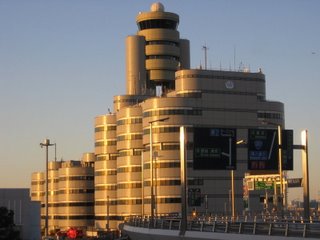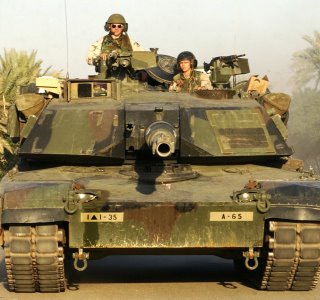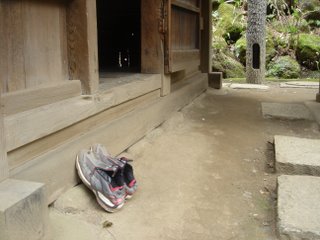As we left off last time, Lyani and I were sitting at gate 16 in Tokyo International Airport, waiting to board our plane. I was blogging away, trying frantically to catch up to the present--or so Lyani said. She cracked a joke about the piano player in this episode of "Family Guy", who is singing a narrative account of the Griffin family's post-apocalyptic journey, which rapidly becomes real-time (warning: Lyani and I think this is the worst episode of "Family Guy" ever). Our plane had pulled up to the gate, and I finished my blog entry and powered down my laptop.
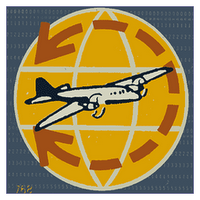 And now, let me take this opportunity to introduce you to one of the most amazing aviation sites on the Internet: AirLiners.net. I learned about it from the superb "Ask the Pilot" column on Salon.com (the Pilot, alias "Patrick Smith", also has a book out, which I would highly recommend that you buy from Amazon!). Patrick Smith is an airliner pilot (currently on furlough, thanks to 9/11 and the havoc that our heavy-handed, inept attempts at "securing our airports" has wreaked on the airline industry) who writes about the joys of flying--interestingly, what excites him the most is not the defying gravity bit, but the fact that you can get on an airliner in Boston and step off halfway around the world--speaks frankly about security as it applies to commercial aviation, and dispenses much wisdom on the safety of modern air travel (hint: flying is the safest way to travel by several orders of magnitude). He also makes heavy use of the aforementioned AirLiners.net (you wondered if I was going to remember to get back to that, didn't you?) in his column, linking to photos when making a point about specific models of planes, airports, etc. But, most exciting of all (at least for this geek) was the revelation that every aircraft has a registration number--usually located on the tail--that stays with it from the day it is built to the day it is retired from flying. This identifier even persists when one airline sells the plane to another! And wouldn't you know it, AirLiners.net allows you to search by registration number!
And now, let me take this opportunity to introduce you to one of the most amazing aviation sites on the Internet: AirLiners.net. I learned about it from the superb "Ask the Pilot" column on Salon.com (the Pilot, alias "Patrick Smith", also has a book out, which I would highly recommend that you buy from Amazon!). Patrick Smith is an airliner pilot (currently on furlough, thanks to 9/11 and the havoc that our heavy-handed, inept attempts at "securing our airports" has wreaked on the airline industry) who writes about the joys of flying--interestingly, what excites him the most is not the defying gravity bit, but the fact that you can get on an airliner in Boston and step off halfway around the world--speaks frankly about security as it applies to commercial aviation, and dispenses much wisdom on the safety of modern air travel (hint: flying is the safest way to travel by several orders of magnitude). He also makes heavy use of the aforementioned AirLiners.net (you wondered if I was going to remember to get back to that, didn't you?) in his column, linking to photos when making a point about specific models of planes, airports, etc. But, most exciting of all (at least for this geek) was the revelation that every aircraft has a registration number--usually located on the tail--that stays with it from the day it is built to the day it is retired from flying. This identifier even persists when one airline sells the plane to another! And wouldn't you know it, AirLiners.net allows you to search by registration number!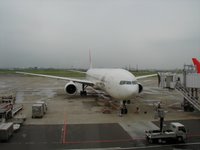 So I made sure to write down the registration number of our Boeing 777-300 (actually, thanks to AirLiners.net, I learned that not only was it a 777-300, but it was a 777-346!) so that I could search AirLiners.net for photos of this exact plane to see where it had been. Well, I am writing this from our hotel in Sapporo (the Hotel Monterey Sapporo, which I would highly recommend if you ever find yourself looking for accommodations in Sapporo), which has a broadband Internet connexion, so I have access to all the photos of our lovely plane that my little heart desires. If you, gentle reader, would but clicky clicky upon my photo of our plane, at right, you will be whisked away to the magical world of AirLiners.net, which offers a bountiful harvest of photographic documentation of the very plane we rode to Sapporo in! Ain't technology miraculous?
So I made sure to write down the registration number of our Boeing 777-300 (actually, thanks to AirLiners.net, I learned that not only was it a 777-300, but it was a 777-346!) so that I could search AirLiners.net for photos of this exact plane to see where it had been. Well, I am writing this from our hotel in Sapporo (the Hotel Monterey Sapporo, which I would highly recommend if you ever find yourself looking for accommodations in Sapporo), which has a broadband Internet connexion, so I have access to all the photos of our lovely plane that my little heart desires. If you, gentle reader, would but clicky clicky upon my photo of our plane, at right, you will be whisked away to the magical world of AirLiners.net, which offers a bountiful harvest of photographic documentation of the very plane we rode to Sapporo in! Ain't technology miraculous?The plane, it would seem, is pretty young, as the earliest picture I found on AirLiners.net dates from 2003. And in fact, with a quick Google search, I found this page, which has a listing for our plane indicating that it was delivered to Japan Airlines on November 13, 2003. Amazing what you can find out with Google these days! (It seems that Patrick mentioned a way to find the production date of any airliner, provided you knew its registration number, in one of his columns, but I cannot recall it right now.)
Anyway, I think I am done geeking out now about information technology, so let me move on to the flight itself.
As I just noted, our plane was pretty new. And it looked the part: the seats were clean and unworn, the inner fuselage was spotless, and even the metal frames of the seats (the part that is bolted to the cabin floor) were shiny. Contrast this to the condition of the plane during your last domestic flight in the US, and don't give me the "but that plane was older" spiel, because a) it probably wasn't, and b) so what? you can replace seats, cabin panels, carpet, etc. We sat in the very back of the plane, where the side columns of seats were only two abreast, and it was an ideal place to sit. Well, other than the fact that JAL did not have passengers board by row number, which meant that we had to wait for people who were sitting in the front of the plane, but who had gotten on before us, to stow their carry-on baggage and get out of the aisle before we could pass. Come on, JAL, show some of that Japanese optimisation that made Toyota the world's most successful automotive manufacturer! Oh, but while I am on boarding, let me just say that other than the sub-optimal ordering, the process was amazingly smooth. When the boarding call for our flight sounded, a huge queue immediately formed (of course, it was one of the neatest lines that I have ever seen, Japanese people being the proficient queuers that they are) behind the gate. Lyani and I were probably the hundredth people in the queue, and we figured it would take all day to get on the plane. The line did not move at all for about five minutes (I think they were pre-boarding the elderly, disabled, and mothers with small children), but then it started moving, and it moved as fast as we could walk! Unbelievable! They had a pair of train station-like turnstiles in front of the entrance to the Jetway, and you just walked up and handed your boarding pass to the attendant, who stuck it into the turnstile just like you would your train ticket. It then popped out the other side and the attendant grabbed it and handed it back to you with a smile and a "arigatou gozaimasu". The process could have been completely automated, but leave it to Japanese companies to make sure that o-kyaku-sama (the customer-god) does not even have to go to the trouble of inserting his own boarding pass in the machine! :)
The coolest thing was that, from the moment we entered the airport to the moment we left on the other end, not once were we asked for photo identification! Contrast this with America, where you must show your photo ID at check-in, again at security, and possibly a third time at the gate, despite there being no laws on the books that require such a thing. Japan's approach to airport security was as close to perfect as I have seen: no making you take off your shoes, no confiscation of your tweezers and nail clippers (having my pocket knife taken was a little on the silly side, given the size of the blade and the fact that I could have easily improvised a better knife from materials readily available on the plane, but the way they handled it took the sting out of it), and best of all, no surly security personnel blaming you for the fact that their job sucks. Japanese airport security screeners probably have a crappy job, but they certainly do not let o-kyaku-sama see that written on their faces. They just screen for explosives and machine guns and let you through with no hassle and no sinking suspicion that Big Brother is watching you.
Oh yes, the flight. That is what I was supposed to be talking about in this entry!
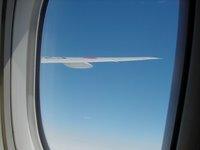 Like I said, the cabin was clean and well-appointed. We had a decent amount of leg room, our tray tables were clean and in good shape, the cabin service was excellent (the flight was just over an hour, so there was only beverage service), and the flight was smooth. The weather was gloomy and overcast in Tokyo, but we shortly climbed above the clouds into a brilliant blue sky (pictured at left), puffy clouds below and not a care in the world. We spent just about an hour above the clouds, though we were flying at a low enough altitude to catch glimpses of the scenery below through gaps in the cloud cover. As we were leaving the northern coast of Honshu, the clouds gave way to reveal some lovely bits of coastline, and then we were over the Tsugaru Strait (the bit of water separating Honshu from Hokkaido and connecting the Pacific Ocean to the Sea of Japan.
Like I said, the cabin was clean and well-appointed. We had a decent amount of leg room, our tray tables were clean and in good shape, the cabin service was excellent (the flight was just over an hour, so there was only beverage service), and the flight was smooth. The weather was gloomy and overcast in Tokyo, but we shortly climbed above the clouds into a brilliant blue sky (pictured at left), puffy clouds below and not a care in the world. We spent just about an hour above the clouds, though we were flying at a low enough altitude to catch glimpses of the scenery below through gaps in the cloud cover. As we were leaving the northern coast of Honshu, the clouds gave way to reveal some lovely bits of coastline, and then we were over the Tsugaru Strait (the bit of water separating Honshu from Hokkaido and connecting the Pacific Ocean to the Sea of Japan.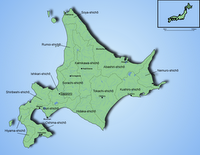 It took longer than I thought it would to cross the channel, it being only about 20 kilometres across. Of course, now that I look at a map of Hokkaido (pictured at right), I see that to fly to Sapporo, we would have probably been flying not across the strait proper, but rather across the large "bay" of the Pacific Ocean between Honshu and Hokkaido. In any case, we flew over the ocean for a few minutes, then made landfall on Hokkaido, and less than five minutes later, we were landing at Shin-Chitose International Airport (or CTS, in IATA parlance--not SAP, which turns out to be a small airport in Honduras, and also the reason why I could not find any direct flights from HND to SAP when I was searching on Travelocity and its ilk).
It took longer than I thought it would to cross the channel, it being only about 20 kilometres across. Of course, now that I look at a map of Hokkaido (pictured at right), I see that to fly to Sapporo, we would have probably been flying not across the strait proper, but rather across the large "bay" of the Pacific Ocean between Honshu and Hokkaido. In any case, we flew over the ocean for a few minutes, then made landfall on Hokkaido, and less than five minutes later, we were landing at Shin-Chitose International Airport (or CTS, in IATA parlance--not SAP, which turns out to be a small airport in Honduras, and also the reason why I could not find any direct flights from HND to SAP when I was searching on Travelocity and its ilk).From Shin-Chitose, we took an escalator into the B1 level of the airport and walked through an underground passageway to JR Shin-Chitose Station. After discovering that JR Hokkaido still does not accept Suica, we purchased two tickets for around 1000 yen (just under $10 US) each for Sapporo. We boarded the train, found seats (thank goodness!) and settled in for a train ride that took just under an hour.
And that, ladies and gentlemen, is how Lyani and I got to Sapporo. I love Japan's public transportation system: we got on the train, rode it right into Haneda, flew to Hokkaido, got on another train, and got off in Sapporo within two blocks of our hotel. Now that is convenience!
